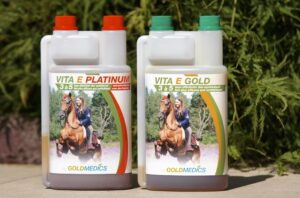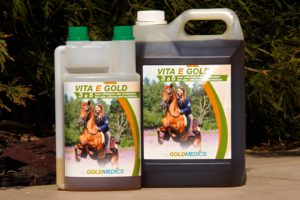These are five different muscle disorders that can be traced back to a deficiency of natural Vitamin E or where Vitamin E is an essential element of the treatment.
Many of these conditions have catastrophic consequences, so try to avoid them. Check the Vitamin E level in the blood at regular intervals: if it is well within the limits you are safe unless there are clinical symptoms. If you are at the lower limit and you are feeding concentrates, then there is probably a deficiency (after all, the analysis procedure does not distinguish between synthetic and natural vitamin E).
Always supplement below the lower limit with a high-quality natural Vitamin E supplement, preferably in a liquid form and in a fat matrix

EMND:
Equine Motor Neuron Disease usually occurs in older horses that have been deficient in vitamin E for > 18 months. EMND affects lower motor neurons (neuron=nerve cell that processes information or signals) and interferes with neurological input in muscles. Affected horses show muscle atrophy, weakness and weight loss and sweating. Affected horses may carry their heads lower than normal and lie for extended periods.
For affected horses, treatment involves increasing vitamin E levels in the diet. The only biologically active form of vitamin E is α-tocopherol. The natural form, d-α-tocopherol, is more bioavailable, more easily absorbed and has greater antioxidant activity than the synthetic form, dl-α-tocopherol (also called all-rac-α-tocopherol). It is not recommended to use the synthetic product in any dosage as it is not effective in increasing the vitamin E level in the blood.
With treatment, about 40 percent of horses affected by EMND improve; 40 percent stabilizes; and 20 percent worsened in disease severity. Those who stabilize can have a good quality of life, but are not fit for performance. Horses diagnosed with EMND are not safe to ride.
EDM
Degenerative Myeloencephalopathy (EDM) is clinically indistinguishable from Equine Neuroaxonal Dystrophy Neuroaxonal Dystrophy (eNAD) in horses; the only difference between these conditions is the location of axonal degeneration in the central nervous system. Horses with eNAD/EDM usually show signs of mild to severe gait abnormalities (ataxia) affecting all four limbs, although the hind legs are usually more severely affected. Clinical signs of eNAD/EDM are usually first observed in young horses (two years of age or younger). eNAD/EDM appears to be inherited and it has been reported that eNAD/EDM affected foals often have low serum vitamin E concentrations. This disease has a genetic basis, with clinical expression in genetically predisposed foals being influenced by dietary vitamin E. The genetic defect underlying the development of eNAD/EDM is currently under investigation.
PSSM
Polysaccharide storage myopathy (PSSM) is a collective name for a group of muscle diseases that occur in horses of different breeds. Horses with PSSM may exhibit a variety of clinical signs, including muscle stiffness, excessive sweating, unwillingness to walk, impaired performance, muscle loss, muscle tremors, attacks of muscle laminitis and coffee-colored urine. These symptoms are also summarized under the name ‘muscle laminitis’, but not every muscle laminity is PSSM (see further by Tying up). Blood tests often show an increased concentration of muscle enzymes. Microscopic examination of a muscle biopsy from horses with PSSM shows an abnormal accumulation of sugar molecules in the muscle cells. Different types of PSSM are distinguished: PSSM1 and PSSM2. Where PSSM1 is a clearly defined disease with a fixed genetic background and PSSM2 is a collective name for other muscle diseases in which there is also abnormal sugar accumulation in the muscle cells, but there is no genetic abnormality that causes PSSM1. PSSM2 is therefore not one specific disease, but a collective name for a group of muscle diseases with an accumulation of sugar molecules in the muscle cells.
Unfortunately, it is not possible to cure PSSM. Once the diagnosis of PSSM has been confirmed, it is important to adjust the horse’s management to prevent attacks of this type of muscle laminitis. Two things are important here. First, adjusting the horse’s ration. The content of sugars in the feed should be limited. In horses with a high energy requirement (and who are not overweight!) fats can be used as an additional source of energy. Horses with PSSM also have a higher need for vitamin E and this should therefore be fed. Secondly, it is very important to give the horse daily exercise on a very regular basis to activate the metabolism in the muscles. Muscle soreness attacks in horses with PSSM mainly occur after a few days of rest. In >75% of the horses where the diet and the exercise regime have been adjusted, no attacks of muscle laminity are seen anymore.
If the horse does show signs of muscle paralysis, it is important to immediately give the horse box rest and to notify a vet. Depending on the severity of the attack, the vet can institute appropriate treatment. Depending on the severity, this can consist of pain relief, drugs to stimulate the blood circulation in the muscles and infusion to flush out harmful waste products from the muscles.
White Muscle Disease
Also called nutritional dystrophy or WMD, it leads to progressive paralysis in which the foal can no longer stand and the sucking reflex decreases. The disease is caused by a deficiency of selenium and/or vitamin E in the soil and in the roughage. In general, the mortality rate in foals that develop the condition is 30% to 45% if supplementation is not taken in time.
Tying up (ER)
Work-related myopathy (also called “muscle laminitis” or “recurrent or exertional rhabdomyolysis (ER)”).
Besides a highly probable hereditary factor, there seems to be no single cause causing ER in horses. Exercise is always one factor, but exercise is always accompanied by another factor. It is likely that several factors must work together to trigger an ER attack.
Other possible factors include:
† Overfeeding non-structural carbohydrates (for example, grains and pellets)
† Poor fitness or fitness, sudden increase in work pressure
† The work of a horse after a rest period, if the concentrate ration was not reduced
† Electrolyte or mineral imbalance, especially seen with Potassium
† A deficiency of selenium or vitamin E
† Imbalance of hormones, including reproductive hormones in nervous fillies and mares and thyroid hormones in horses with hypothyroidism
† Wet, cold or windy weather conditions
The more factors present, the more likely the horse is to develop ER. However, the most common cause of ER is an imbalance between the animal’s diet and its workload, especially if it is on a grain-rich diet.
ER occurs when there is not enough blood flowing to the muscles of a working horse. The muscle cells, without oxygen, begin to function anaerobically to produce the necessary ATP. The anaerobic work creates a build-up of waste products, acid and heat. The cell membranes can then be damaged if the horse is forced to work, causing muscle enzymes and myoglobin to leak into the bloodstream.
The body builds glycogen from converted carbohydrates in muscle cells. Glycogen, a fuel used by muscles for energy, is depleted during work and replenished when a horse rests. Oxygenated blood metabolizes glycogen, but the blood cannot flow fast enough to metabolize the excess stored glycogen. The glycogen that is not metabolized aerobically (by the oxygenated blood) must then be metabolized anaerobically, which then creates the cell waste products and heat and ER is started. A horse fed a grain-rich diet with little work accumulates more glycogen in its muscles than it can use efficiently when training begins, therefore horses fed a grain-rich diet are more likely to have ER.
Proper conditioning can help prevent ER as it promotes capillary growth in muscle and the number of enzymes used for energy production in muscle cells. However, improvement in these areas may take several weeks. So ER is more common in horses that are only sporadically or lightly trained, and in horses just starting a training regimen.
A common misconception is that ER is caused by the buildup of lactic acid. Lactate is not a waste product for a cell, but a fuel that is used when the oxygen supply of the cell is insufficient. Lactate does not damage a cell, but rather is a byproduct of the true cause of cell damage: insufficient blood supply and altered cell function. Lactate builds up naturally in a horse in motion without damaging muscle cells, and is metabolized within an hour.
The pain is caused by the insufficient blood supply to the muscle tissue, the inflammation from the resulting cell damage and the release of cell contents. Muscle spasms, caused by the lack of blood to the muscle tissue, are also painful.
Adding vitamin E to the diet of horses prone to tying up is also recommended to increase the integrity of the muscle membrane. Amounts of up to 5,000 IU of vitamin E per day have been shown to be effective in reducing leakage of muscle enzymes from the cells.

